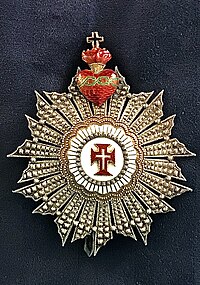| Imperial Order of Christ Imperial Ordem de Cristo | |
|---|---|
 Grand Cross star of the Imperial Order of Our Lord Jesus Christ | |
| Awarded by Brazilian Imperial Family | |
| Type | Dynastic Order |
| Established | 7 December 1822 1822–1890 (National Order) 1890–present (House Order) |
| Royal house | House of Orleans-Braganza |
| Status | Cancelled as national order in 1890, since then claimed as house order |
| Grand Master | Disputed:[1] Prince Bertrand of Orléans-Braganza Prince Pedro Carlos of Orléans-Braganza |
| Grades |
|
| Precedence | |
| Next (higher) | none (highest) |
| Next (lower) | Imperial Order of Aviz |
Ribbon bar of the Order | |
The Imperial Order of Our Lord Jesus Christ (Portuguese: Imperial Ordem de Nosso Senhor Jesus Cristo),[a] often simply named Order of Christ, is an order of chivalry instituted by emperor Pedro I of Brazil on 7 December 1822, on the basis of the Portuguese Order of Christ founded by King Dom Dinis and Pope John XXII in 1316–1319.
The order was used to award persons for exceptional services that resulted in notable and proven utility to religion (Roman Catholicism), to humanity and the state. Knights of the Order of Christ were part of the untitled nobility of the Empire of Brazil.
On 22 March 1890, the order was cancelled as national order by the interim government of United States of Brazil. However, since the deposition in 1889 of the last Brazilian monarch, Emperor Pedro II, the order is claimed as a house order, being awarded by the heads of the House of Orleans-Braganza, pretenders to the defunct throne of Brazil. The current Brazilian Imperial Family is split into two branches, Petrópolis and Vassouras, and the Grand Mastership of the Order is disputed between those two branches.
- ^ Register of Orders of Chivalry. ISBN 979-12-20389-43-3 © 2022 International Commission for Orders of Chivalry (Commissione Internazionale permanente per lo studio degli Ordini Cavallereschi), p. 40
Cite error: There are <ref group=lower-alpha> tags or {{efn}} templates on this page, but the references will not show without a {{reflist|group=lower-alpha}} template or {{notelist}} template (see the help page).